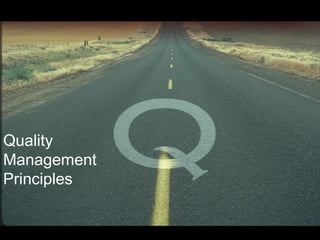
Quality management principles
- 2. Quality Management Principles standardized by ISO 1. Customer focused Organization 2. Leadership 3. Involvement of people 4. Process orientation 5. System approach to management 6. Continuous Improvement 7. Factual approach to decision making 8. Mutually beneficial supplier relationships.
- 3. 1. Customer focused Organization Organizations depend on their customers and therefore should understand current and future needs, meet customer requirements and strive to exceed customer expectations. This requires : • Identification of customers ( Internal & external ) • Understanding stated and implied needs / expectations. • Establishing measures of satisfaction customer needs/ expectations.
- 4. Customer focused Organization • Determining how far customer needs are being met at present. • Efficient processing of customer complaints. • Establishing customer focus down the line including distributors. • Seeking customer feedback and its analysis for taking measures to improve customer satisfaction.
- 5. 2. Leadership Leaders establish unity of purpose and direction of the organization. They should create and maintain the internal environment in which people can become fully involved in achieving the organization's objectives. This requires the following steps : • Establish long term vision and strategy. • Enlist others in a common vision by appealing to their values, interests, hopes and dreams.
- 6. Leadership • Search for challenging opportunities to change, grow, innovate and improve. • Experiment, take risk and learn from the mistakes. • Foster collaboration by promoting cooperative goals and building trust.
- 7. Leadership • Strengthening others by sharing information and power and increasing their discretion and visibility. • Set an example by behaving in the ways that is consistent with the stated values. • Plan small wins that promote consistent progress and build commitment. • Recognize individual contributions to the success of every project.
- 8. 3. Involvement of people People at all levels are the essence of an organization and their full involvement enables their abilities to be used for the organization’s benefit. This requires : • Employees must be treated with dignity and respect. • They must be trained to build competence where required. • Each employee must know what exactly is required to be done and where possible must be able to assess the quality of his work. • Fear must be totally removed from the organization and employees must be encouraged to bring out weakness in the system.
- 9. Involvement of people • Empower employees to take appropriate action in their area of work for improvement. • In case of a mistake, examine the system rather than the man to prevent its recurrence. • Involve employees in quality plans and draw upon their intimate knowledge of processes for improvement. • Assess employee satisfaction level and take appropriate measures to improve their morale so that they take pride in belonging to the company.
- 10. 4. Process orientation A desired result is achieved more efficiently when related resources and activities are managed as a process. This requires : • Planning of processes to meet customer requirements. • Process capability study and qualification of process. • Establishment of mechanism to keep process under control. • Ownership of process with full responsibility of quality.
- 11. Process orientation • Verification of product/ service for conformance before instruments. • Maintenance/ calibration of process equipments and measuring instruments. • Analysis of process data for improvement.
- 12. 5. System approach to management Identifying, understanding and managing a system of interrelated processes for a given objective improves the organization’s effectiveness and efficiency. This requires -
- 13. System approach to management • Clear objectives. • Organizational structure with well defined authority and responsibility. • Planning for Quality . • Control of functions affecting quality. • Coordinating of interrelated processes. • Audit mechanism for self regulated organization.
- 14. 6. Continuous Improvement Continuous improvement should be a permanent objective of the organization. This requires : • Measurement of quality. • Analysis of quality data and investigations for non conformities. • Seeking opportunities for improvement rather than reacting to quality problems. • Benchmarking.
- 15. Continuous Improvement • Organization for quality improvement like quality circles, quality improvement teams for taking up specific projects. • Review of Q.I.P’s ( Quality Improvement Projects ) by top management. • Recognition of significant achievements.
- 16. 7. Factual approach to decision making Effective decisions are based on the analysis of data and information. This requires : Recording of data on : Quantitative production Equipment failures Process conditions Delivery performance Customer complaints Quality costs Supplier performance.
- 17. Factual approach to decision making • Ensuring the data is accurate, reliable and accessible. • Analysis of data to understand the impact on organizational performance and cost implications and for deciding corrective actions. • Data on results of application of corrective action.
- 18. 8. Mutually beneficial supplier relationships . An organization and its suppliers are interdependent, and a mutually beneficial relationship enhances the ability of both to create value. This requires : • Consideration of quality capability while selecting vendors. • Specification of quality on purchase documents. • Clear understanding of supplier needs.
- 19. Mutually beneficial supplier relationships. • Mutual trust and share responsibility and accountability. • Clear and open communication. • Mutual commitment for continuous improvement.
- 20. FICCI CE
